Super Mario Bros. tells a story. It’s not a very complicated story — Mario saves the princess from an overgrown turtle — but it’s a story nonetheless. And the game embellishes that story through small details. For instance, after liberating the castle of the second world and the illusory Bowser within, Mario resumes his quest in the dark of night.
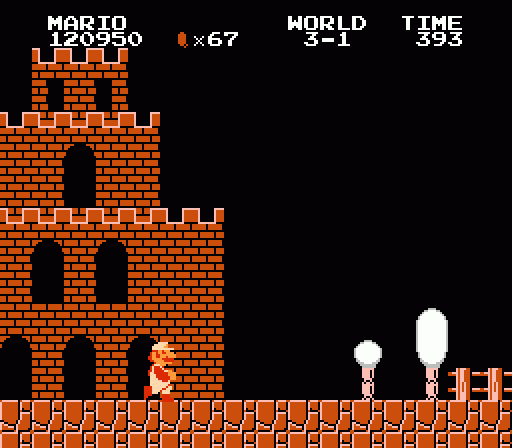
How else do you explain the sudden darkness of the overworld areas in World 3? You’re not underground, because you can see trees and clouds; and it’s not like Super Mario Bros. 3, where the sky grows black once you enter Bowser’s domain. You’re traveling across the Mushroom Kingdom here, and the final two levels actually feature blue skies. Nope, Mario’s journey across the Mushroom Kingdom spans two nights and three days. What a champ.
Now, I’m not discounting the possibility that Mario just chills out in the castles for a few hours after defeating them. Or, being a plumber, maybe he goes to work trying to figure out how to dredge and drain all that magma in the basement. He’s cool like that.
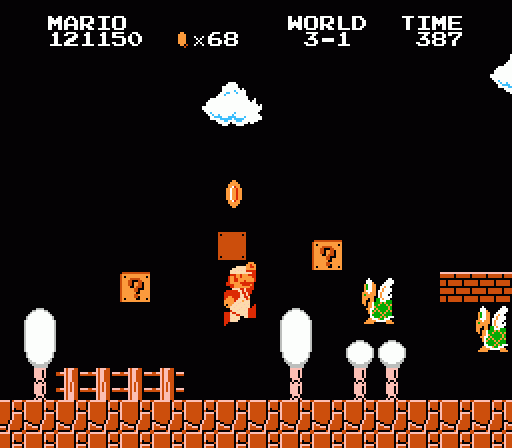
World 3-1 is the most generous stage since 1-1 when it comes to handing out power-ups: You have no less than four opportunities to grab a Super Mushroom or Fire Flower here. Some are hidden, sure, but that’s par for the course at this point.
The reason for World 3-1’s generosity? It’s the toughest normal stage yet, introducing a couple of new enemy types. There’s an expectation here that you’re going to find yourself in over your head, so the level gives you ample opportunities to beef up and procure a Fire Flower… or simply return to super size after you’re inevitably reduced to tiny Mario upon taking damage.
Your first new challenge shows up straight away: Green Koopa Paratroopas. You’ve met Paratroopas before, but those were the red variety that simply hover up and down in place. The green type, on the other hand, knows no such restraint. It travels forward in a dogged advance, like its ground-based cousins, but it does so in bounding leaps. This makes it a much more difficult target to deal with, since Mario has to time his jumps so that he’ll hit the Paratroopa from above rather than letting it come down on his head (though of course with excellent timing, normal Mario can pretty easily run beneath them; for Super Mario it’s a little more difficult).
Since this is the first time you deal with them, the game gives you a few outs. You can wait for them to come to you, or you can simply use the Question Blocks as platforms to bypass them altogether — the first block is conspicuously lower than the other two, beckoning you to an obvious route overhead. And once you get past them, your reward is a Super Mushroom.
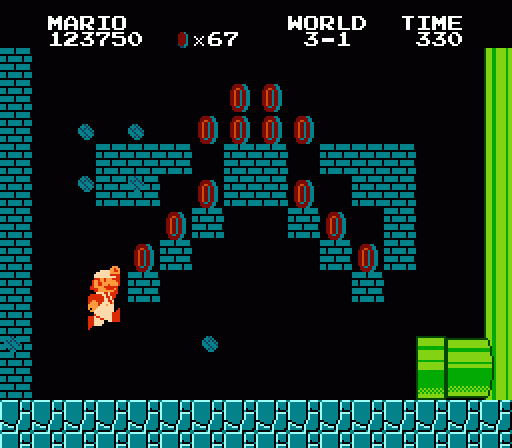
Shortly after, you can drop into a bonus room via pipe, and inside is another power-up. What’s interesting here is that the single blocks at the bottom prevent normal Mario from reaching the power-up in the top area; you have to break the blocks as Super Mario. This is the first time we’ve seen power-ups locked away behind some kind of situation requiring an existing power-up; it’s both a way to scold players for being sloppy enough for somehow failing to make it the short distance from the previous power-up to the pipe where this one’s hidden (to a small degree) as well as a way of ensuring players are properly equipped for the remainder of the stage and the challenges ahead (to a greater degree).

Much of the level consists of standard enemy formations in slightly new situations. The water theme of World 2 carries over very slightly here with a broken bridge across a river — something new — but it’s patrolled by Goombas — old hat.
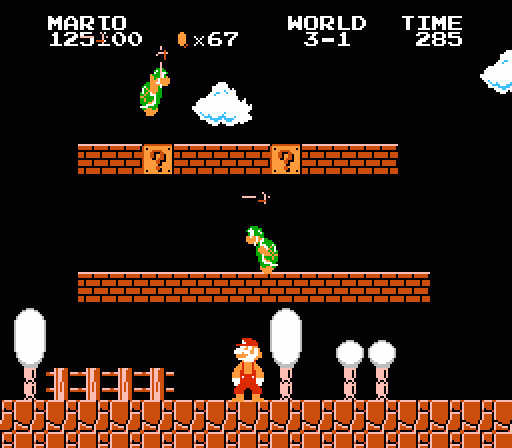
But all of this is simply preamble to the appearance of the real threat in World 3-1: The Hammer Bros.
The Hammer Bros. will appear throughout the remainder of the quest, and they are in my opinion the most dangerous and threatening foes in the entire game. Super Mario Bros. seems to agree, as each Bro yields a tidy 1000 points upon its defeat. These guys don’t move much — they roam back and forth across a span of ground a few blocks wide, really — but rather than presenting a lateral threat they control the vertical. Most Hammer Bros. encounters have them in areas like this, where they can jump freely between two different levels of bricks.
As they jump up and down, they also chuck hammers… lots of hammers. Their projectiles rise up slightly, make a sharp turn, and drop back to the ground. The hammers pose the real threat here, because they stream forward in a deadly shower. There’ll be breaks in their movement, of course, or else it would be impossible to get past them. And the brick-punching skills you’ve learned elsewhere come in handy for clearing out Bros. above you (the hammers make it very difficult to attack them from above), but even then you have to be careful not to punch a hole in the lower platform that the higher Hammer Bro could drop down into.
This particular sequence, where you meet the Hammer Bros. for the first time, totally embodies the thoughtful design discipline behind Super Mario Bros. Because they represent a different (and arguably greater) kind of threat than anything you’ve faced before, they could easily be overwhelming for a first-time player. But shortly before you face them, you can grab a Starman to become invincible, negating the threat of the Hammer Bros. for this introduction. You have a short window of safety to take a look at their skills and behavior and familiarize yourself with them for this one encounter; the next time you meet them, you won’t have the Starman to keep you safe. But because Super Mario Bros. gave you this chance to learn about them within a bubble of safety, you’re prepared to face them the second time.
This is great game design. Nothing unfair, nothing arbitrary; just direct challenges that are revealed one by one, methodically, for the observant player to learn from. The very specific placement of the Starman in this level really drives home that nothing about the way Super Mario Bros. unfolds is accidental or haphazard.

Another interesting feature of the Hammer Bros. encounter: Shortly beyond it you’ll find a springboard that can propel you onto some bricks high above. But, if you take a running jump from the middle level of the Hammer Bros. platforms, you can land on the lower deck of the bricks above the springboard. (It’s possible to do this from the spring, but very difficult.) Hidden in one of the bricks above is a secret vine that will take you to a coin-packed bonus area. Nothing indicates the vine’s presence besides a tease for your sense of curiosity: You spring up to the top level and wonder, hmm, what’s in the bricks I’m standing on? Can I get down there without falling into the pit below? It’s not quite a puzzle, but it pushes in that direction: An interesting problem to solve for those with a compulsion to explore the contents of every possible brick in the game.
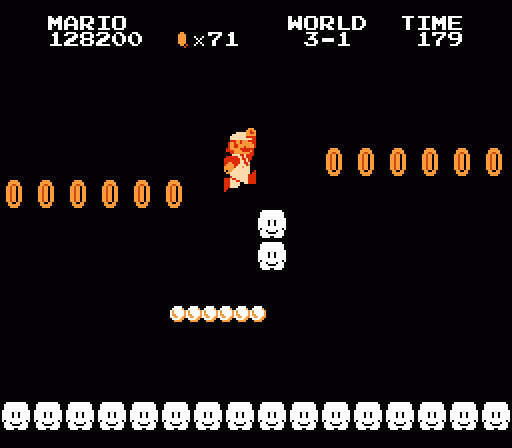
The bonus area also raises the stakes slightly, making you work for your loot. Besides forcing you to keep pace on a moving platform while jumping to collect coins, you also have to leap over (or duck beneath) occasional obstructions that would otherwise scrape you from the platform. It adds just a touch of complication over the game’s previous cloud area — nothing dangerous, but demanding more attentive and responsive play as you travel further into the adventure.
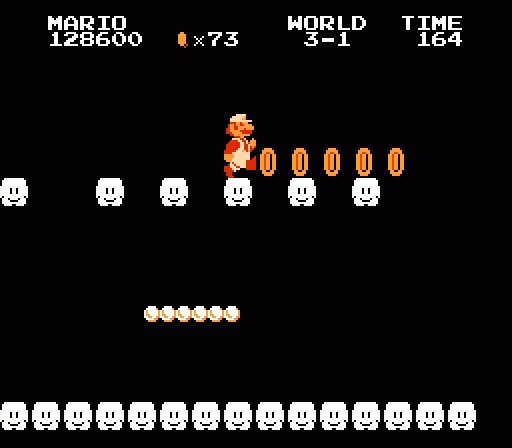
And another lesson to be learned: Mario can run over single-block gaps with his B-dash. This isn’t necessarily an intuitive action, so the game teaches you here in a safe place by planting coins over single-space gaps with no risk of dying if you screw up. You can try to collect them all by jumping, but it’s difficult and imprecise. But you may make the connection here that you can dash over these small gaps — a skill that proves to be essential down the road.

And finally, of course, the main draw of World 3-1 for advanced players: The infamous infinite lives factory. Thanks to a quirk in the game physics, Mario can jump on the turtle descending the steps at the end (which echo the Goombas on the stairs at the beginning of the stage) and jump-kick it in such a way that the arc of Mario’s bounce aligns with the rebound of the Koopa Troopa’s shell. This creates a potentially endless loop in which Mario racks up multiplying points for each time he lands on the shell, which quickly become extra lives.
This wasn’t a deliberate inclusion, but it’s become such an essential part of the Mario lore that many sequels incorporate it. It’s a simple, logical extension of the play mechanics — one of the earliest examples that comes to mind of a game with physics designed well enough to allow an exploit like this (as opposed to older exploits, which tended to involve glitches and programming errors).
You are making me want to replay SMB so badly.
In fact, the Hammer Bros. do not remain stationary. If you wait long enough, they will go in Mario’s direction. But it takes some time.
What Tomm said. I think it’s time to dust off the old Wii, which is surprisingly my easiest option for playing this right now. I’ll be playing it through an entirely new lens, which I suspect is one of the reasons you do these series.
As a side note (and this might be a long ways off), I don’t know what you’re planning to do next for Anatomy, but I think a series/game you haven’t covered a lot would be pretty fun. Something that’s not nearly as “perfect” as SMB (but neither poorly designed like the games you wrote about a while back). Something like, I dunno, Sonic?
The Hammer Bros. are tricky, but when flowerless I’ve always felt safer against a pair on platforms than against one without.
The pre-SMB3 Hammer Bros. do have a nasty trick where they can jump down two layers if they jump from the top, but if you’ve got the right timing you can kill anyone who tries that by hitting a block as they make contact with it.
As for the 1UP trick, I don’t think I’ve ever pulled it off. Unless the Koopa Troopa kills you or you commit suicide by Time Over, you only get one shot at the trick, and I usually forget to try or screw it up.
I might try learning to pull that off reliably whenever I pick up Super Mario Bros. on 3DS Virtual Console. Wii VC doesn’t have restore states beyond that temporary quick save.
Yeah, with 3DS save states I was finally able to pull it off for the first time.
Another great writeup
Back in the day, the official club Nintendo magazine in Germany wrote, world 3 takes place in winter. Probably because the bright outline on blocks make it look a little snowy. At least, if you squint your eyes hard enough.
I agree with Turkish; I’d be interested in seeing a write-up like this for something you’re not quite as used to as SMB. Sonic would be a great choice, I think.
But I’m doing exactly that. I haven’t played more than a stage or two of SMB since about 1987. And given that this is something I do in my free time, I’d rather stick to games I enjoy.